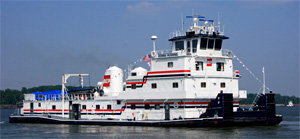From outward appearances the towboat Donna Rushing appears no different than it did when delivered 39 years ago as F. P. Thomas to Thomas Marine Co. by Dravo Corp.
Back then Thomas Marine Co., of Butler, Pa., towed petroleum products for Ashland Refining Co., now known as Marathon Ashland Petroleum.
In 1973, the towboat had 5,600 hp from a pair of 16-cylinder General Motors (EMD) 645-E5 diesels that were eventually upgraded to 6,140 hp through conversions to model 16-645-E7B during successive ownership changes. The towboat finally ended up in the fleet of AEP River Operations, which assumed ownership of several towboats from what was then Memco Barge Line, which had renamed the boat Donna Rushing in 1993.
AEP River Operations now owns or operates 90-plus towboats and 3,000 barges along the Mississippi River system and Gulf Intracoastal Waterway.
AEP engineering and maintenance superintendent and “Go Green” project manager Joe Brantley, said the company hosted a discussion last year regarding the environmental upgrade being contemplated for the veteran towboat as it invited vendors and representatives from different local organizations, including the Coast Guard Center of Expertise, West Kentucky Community and Technical College, the Greater Paducah Sustainability Project/Recycle Now, AEP’s Cook Coal Terminal and James Marine Inc., where the project was undertaken. He said the goal of the meeting was to reach out to vendors and to describe the company’s goal of making Donna Rushing safer, more environmentally friendly and ergonomically beneficial for its crewmembers. Simply put, the aim was make the 39-year-old towboat even better than the new boats being built today.
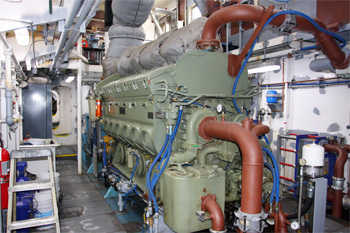 |
|
One of the pair of 3,000-hp 12-cylinder EMD 12-710 engines. |
“Feedback from the meetings was overwhelmingly positive from vendors and crewmembers as well as from the Coast Guard and other environmental agencies,” he noted. “We started building the M/V Donna Rushing of the future.”
The superstructure and dimensions of the 140-by-42-foot hull remain unchanged, but virtually everything inside has been replaced with more than a hundred energy saving and environmentally-friendly components, from the top of the pilothouse to the depths of the bilges.
The most obvious change is in the engine room, which now has a pair of 12-cylinder EMD 12-710 Tier III, EPA-compliant diesel engines — the first of their kind to be installed on an inland river towing vessel. The new engines from Inland Power Group, of Carol Stream, Ill., with only 12 cylinders, are more fuel efficient while still developing 6,000 hp and are coupled to the original Falk reduction gears.
Brantley said he anticipates a 15 percent reduction in fuel consumption with the new engines, which emit less pollution from exhaust emissions. The engines are designed to be able to run on B5 biofuel.
Both generators have been replaced with low-emission CK generators powered by John Deere Tier III 8.1-liter diesels.
A glance around the reconfigured engine room reveals the absence of any disposable fuel or oil filters associated with the new engines. Brantley said the new Moatti filterless system was designed to eliminate the expense and logistics associated with dirty filter disposal.
“We are the first on the river to go filterless,” he said.
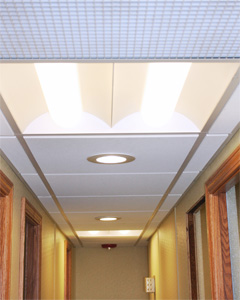 |
|
New LED lighting replaced incandescent fixtures for better illumination and efficiency. Flashlights now use rechargeable batteries. |
Wherever possible, other applications will utilize washable filters made of recycled material to reduce the purchase and disposal of contaminated filter cartridges.
The boat also uses Exxon Mobil’s new environmentally-friendly grease for all external fittings, davits and winches. Bilge contamination is further reduced through the use of Simplan shaft seals to eliminate water from leaking past the shafts and entering the bilge. All wastewater goes through an onboard evaporation system before being discharged overboard. Brantley said the existing Ultra-Sep oily water separator was replaced with a new unit that can separate emulsified substances to bring the levels in the water down to as low as 5 ppm instead of the International Maritime Organization’s minimum requirement of 15 ppm.
When the engines are drained for repairs or overhaul, a spare tank captures cooling water for reuse, eliminating the need for disposing the water with necessary chemical additives. Graywater discharges from sinks and other washing areas go through the marine sanitation system before discharge. Even the deck drain lines are filtered to treat deck runoff before it runs into the river.
Installed throughout the engine room are several innovative systems vital to the vessel’s operation that also eliminate or reduce environmental impact. Included among the updates is a heat exchanger that pumps water through the main engines and generators to provide hot water and heat throughout the vessel. According to Brantley, it is the first installation of this type on an inland river towing vessel. A water purification system uses a pretreatment process to continuously provide clean drinking water to eliminate the need for bottled water and resulting trash disposal. Brita drinking water dispensers have also been installed in the galley and pilothouse.
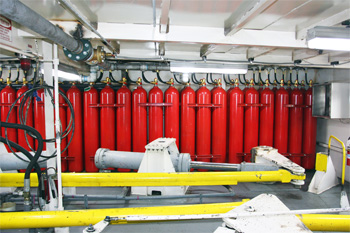 |
|
The Inergen inert gas firefighting system is safer for crews. When deployed, it cuts oxygen levels enough to stop combustion but leaves them high enough to permit people to breathe safely. |
Twelve-volt lights illuminate the engine room with power from the main engines and generators. These 12-volt systems have a backup 120-volt LED system.
All other light bulbs, spotlights and fluorescent lights have been replaced with LED light fixtures to eliminate issues associated with proper disposal of CFL bulbs which are replacing so many incandescent light bulbs currently in service. Even the traditional battery-powered flashlights and barge running lights have been replaced with innovative hand-held lights and dedicated recharging stations to eliminate the purchase and disposal of the alkaline batteries traditionally found on similar towing vessels.
Some of the most obvious changes have occurred in the galley, which features all new equipment and fixtures, including a convection oven to reduce energy consumption while also reducing the load on the air-conditioning system by lowering the ambient temperature in the galley.
The hot-oil fryer has been replaced with a hot-air fryer, which provides healthier food while eliminating the need to dispose of used oil. Even the charcoal grill on deck for traditional Saturday steaks has been replaced with an electric grill. An exhaust hood over the stove has been equipped with a system that uses a fine mist of an environmentally-sound water-based solvent for fire suppression. This type of system is normally found only in restaurants. Dyson hand dryers have been installed in the galley, engine room and forward deck locker to significantly reduce the expense and disposal problem of paper towels.
The original pilothouse console, which had become cluttered through the addition of several new pieces of electronic navigation and communications equipment over the years, was replaced with an attractive ergonomic helm station with many new pieces of equipment flush-mounted for easy access or view.
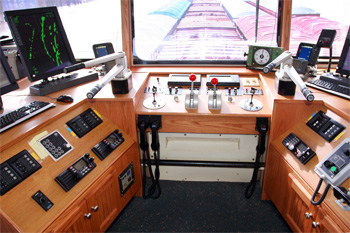 |
|
The pilothouse console was reconfigured to reduce clutter. Much of the electronic gear has been flush-mounted for ease of access and visibility. |
Only water-based paints were used throughout the interior and exterior of the vessel, and where possible, interior flooring, cabin paneling and ceilings were replaced with recycled materials.
Brantley said crew comments are gathered monthly to gauge their reception to the rehab effort and to garner input for changes to be included on the next boat to be brought in for a similar reconstruction and repowering project.
Brantley said AEP River Operations takes its role as an industry leader seriously. “We look forward to M/V Donna Rushing becoming a benchmark for how towboats are both built and renovated in the future.”

